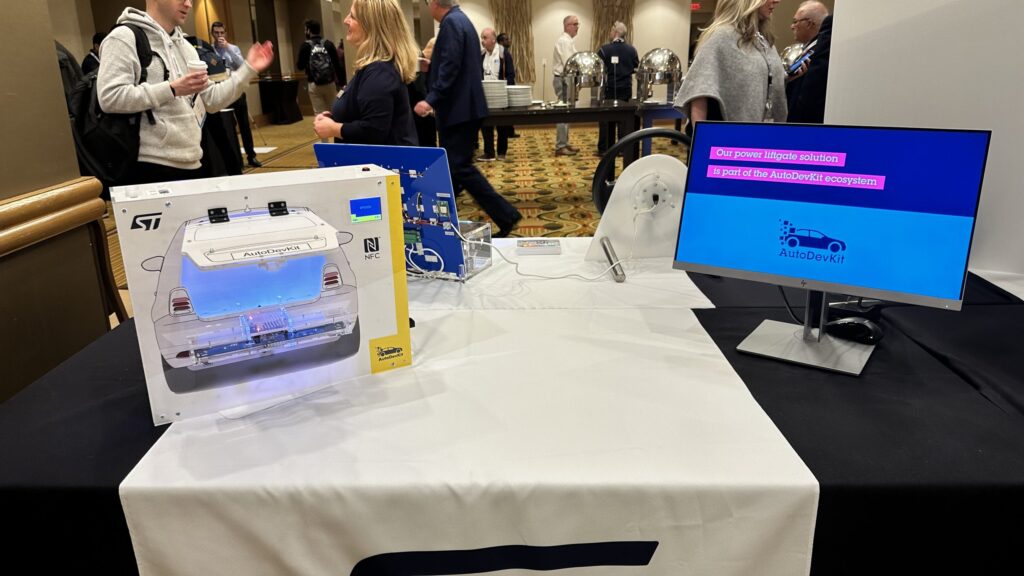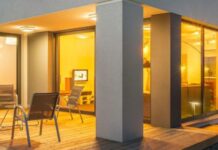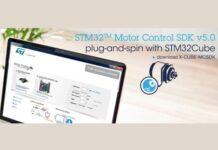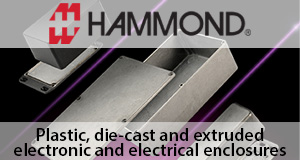The power liftgate built on the AEKD-TRUNKL1 is always a highly popular and easily recognizable demo, as its loud beeps alert attendees that the trunk is in motion. However, behind the scenes, there is a lot more than “meets the ears.” For one thing, while the application focuses on a powered liftgate, the numerous boards and control systems involved can govern the entire rear. Consequently, despite appearances, this isn’t a demo about an application but how engineers can create a zonal architecture. Additionally, the presentation uses cost-effective sensors that many would never have thought to employ in an automotive, leading many integrators to solve detection issues and make their solution more accessible.
AEKD-TRUNKL1 or the creation of a zonal architecture
Witness
The most visible aspect of the demo is the comprehensive nature of the AEKD-TRUNKL1 platform. As the video above shows, there are eight boards involved. Prima facie, users witness the AEK-LED-21DISM1 board as bright lights blink during operation or when sending an alert. Too often, engineers forget that LEDs are a part of the user interface that can significantly enhance the experience. Additionally, attendees hear the acoustic vehicle alerting system (AVAS) handled by the AEK-AUD-C1D9031 board that generates loud beeps thanks to its class D audio amplifier. In fact, many know that the demo is on the show floor before they even see it.
Interact

When users come to interact with the demo, they wave a hand underneath the fake car bumper. It’s at this moment that the time-of-flight sensors of the AEK-SNS-2TOFM1 detect movements and trigger the trunk’s opening or closing. Attendees can also control the application by using the Bluetooth signal from a mobile app that talks to the AEK-COM-BLEV1 Bluetooth communication board. Alternatively, there’s a contactless car key system thanks to the X-NUCLEO-NFC06A1 NFC reader. The AEK-MOT-TK200G1 then controls the motors responsible for moving the trunk gate. Attendees also see the AEK-LCD-DT028V1 display messages that can help developers debug code or showcase features.
Learn
Behind the scenes, the application runs on the host SPC58EC80E5 MCU present in the AEK-MCU-C4MLIT1. Our engineers also added features like movement detection, which stops the motors immediately if the vehicle is in motion. This is possible thanks to the AEK-CON-SENSOR1 sensor board, which houses an inertial MEMS on its DIL 24 socket. Finally, the whole application is available in AutoDevKit Studio to help developers run it rapidly and learn from our implementation. Teams would have to contact their ST representatives as we do not provide the entire demo kit for sale. However, almost all boards are available for purchase, and users can download the AutoDevKit Studio IDE to get started.
Indeed, if one thing shines through this demo, it is that it is bigger than the sum of its parts. The Bluetooth or NFC system can control other features. The AVAS board can alert users of other dangers, and the motor control application can power windows. Put simply, it is time to rethink car applications by framing them in a holistic methodology. It’s easy to break every feature into a subsystem. However, by looking at the back of the vehicle as a whole, combining functionalities onto the same host MCU, and reusing devices, we simplify developments and significantly reduce costs, thus providing more features to mainstream vehicles.
Obviously, ST does not advocate combining all subsystems into one computer. In fact, the benefit of a zonal architecture is its inherent decentralization. For instance, a zonal architecture means that the distance between the sensors and the ECU is far shorter, thus greatly simplifying designs and improving reliability. By using a zonal approach instead of a domain-based architecture, it’s also possible to implement advanced features faster since there are fewer risks of a bug causing serious issues, thus hastening developments and lowering costs. It also makes maintenance operations easier since technicians can focus on a particular zone to more quickly isolate issues compared to scanning the entire car’s software for problems.
On the other hand, installing an ECU to handle only one or two real-time operations at a time can be cumbersome and costly. The AEKD-TRUNKL1 power liftgate demo is thus an object lesson in finding the right balance by adopting a zonal architecture that can make advanced powered liftgate more cost-effective and thus more accessible to entry-level and mainstream vehicles. As MCUs increasingly become powerhouses while keeping consumption down, developers must better utilize their capabilities to combine more functionalities under one ECU. A zonal architecture can thus help bring features currently only present in higher-end models to transform a vehicle’s value proposition.
Power liftgate or the evolution of sensors in cars
Learn

Traditionally, car makers favor sonar to detect the movements under the car that trigger the power liftgate. The issue is that these devices are expensive and not always practical. For instance, accuracy on early models was notoriously low, which forced car makers to publish videos teaching their customers how to “kick” under their bumper to activate the liftgate. Our teams solved this challenge by using multiple time-of-flight sensors instead of sonars. Despite using more devices, the bill of materials is still significantly more cost-effective. Additionally, the system can track a greater range of movements. Users don’t have to learn a precise leg move. Instead, they can perform more natural movements with greater confidence.
Interact
Using time-of-flight sensors on the outside of the car or the inertial MEMS detecting if the vehicle is moving demonstrates that an automotive solution can use more classical and cost-effective devices. Too often, manufacturers use costly devices when sensing the outside world. However, the ST power liftgate demo shows that it is possible to get even better results at a fraction of the cost and with devices that are far easier to source. Put simply, it challenges common assumptions holding the industry back by showing that a device like a time-of-flight or inertial sensor can bring new features to more mainstream vehicles.
Witness
Furthermore, as more sensors embed greater intelligence, like a finite state machine, a DSP, or a machine learning core, makers are witnessing the advent of AI at the edge. There will always be cameras and image recognition software that analyze the road and the car’s surroundings. However, the AEKD-TRUNKL1 demo shows a rise in simpler sensors that provide information to various zones and can even offer edge processing. Consequently, an engineer could install a simpler and more cost-effective communication interface since there will be less data traveling. In a nutshell, the time-of-flight and inertial sensors of the ST power liftgate demo are a sign of new trends shaping the industry.













